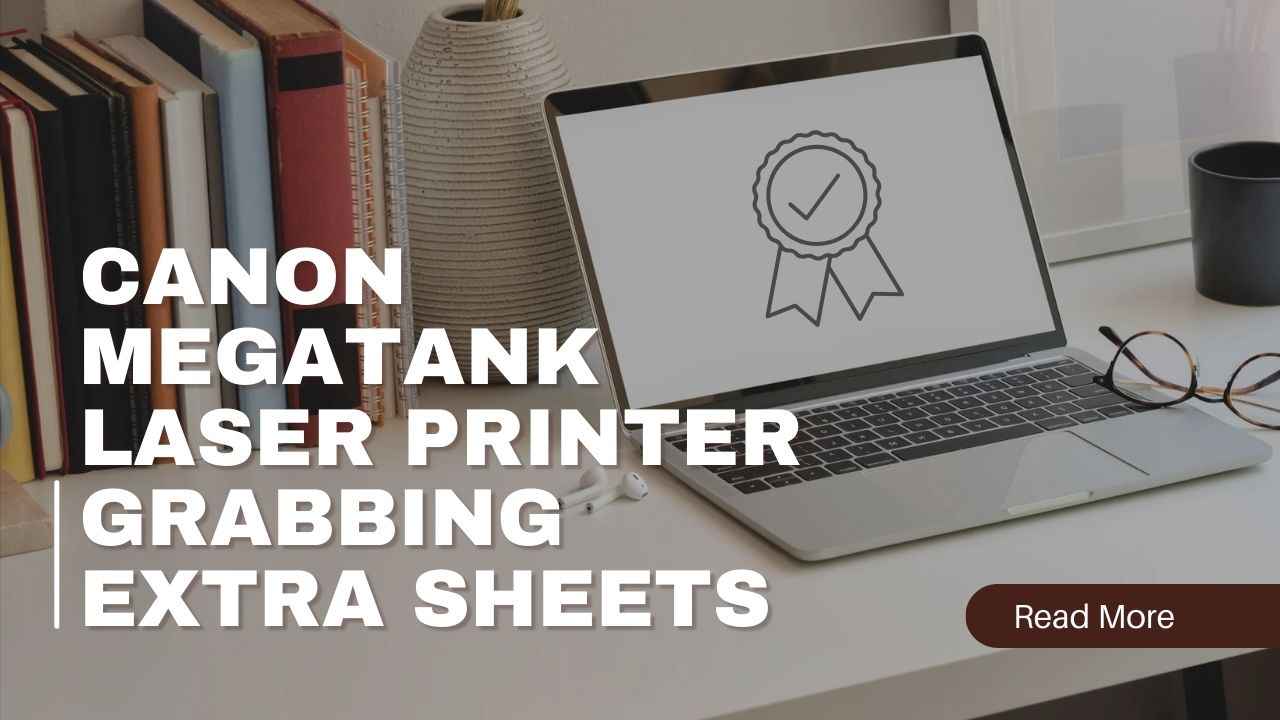Is your Canon MegaTank laser printer grabbing extra sheets and causing frustrating paper waste? This common printing problem affects thousands of Canon users daily, leading to wasted paper, increased costs, and interrupted workflows. When your printer consistently feeds multiple sheets instead of one, it’s not just an inconvenience – it’s a sign that your printer needs immediate attention.
Multiple sheet feeding, also known as multi-feeding, occurs when your printer’s paper pickup mechanism grabs more sheets than intended for each print job. This issue can happen with any paper type but is particularly problematic with thin paper, photo paper, or when using mixed paper weights in the same tray.
The good news is that most cases of multiple sheet feeding can be resolved through simple maintenance procedures and adjustments. Understanding the root causes and implementing the right solutions can restore your Canon MegaTank’s reliable single-sheet feeding performance without requiring expensive repairs or professional service calls.
What Is Multiple Sheet Feeding in Canon Printers?
Multiple sheet feeding, commonly experienced with Canon MegaTank laser printer grabbing extra sheets, occurs when the printer’s paper pickup mechanism fails to separate individual sheets properly during the feeding process. Instead of pulling one sheet at a time, the printer grabs two, three, or even more sheets simultaneously, sending them through the printing mechanism together.
This problem manifests in several ways. You might notice blank pages mixed with printed pages in your output tray, indicating that multiple sheets passed through together. Sometimes you’ll hear unusual sounds during paper feeding, such as grinding or struggling noises as the printer attempts to process multiple sheets. In severe cases, the extra sheets can cause paper jams that require manual intervention to clear.
The issue primarily stems from problems with the printer’s separation mechanisms. Canon printers use rubber rollers, separation pads, and precise pressure adjustments to ensure only one sheet feeds at a time. When these components wear out, become dirty, or lose their grip, they can’t properly separate individual sheets from the paper stack.
Environmental factors also play a significant role. High humidity can cause paper sheets to stick together, while very dry conditions can create static electricity that makes separation difficult. Understanding these underlying causes helps in selecting the most appropriate solution for your specific situation.
8 Proven Ways to Fix Canon MegaTank Paper Feeding Issues

1. Adjust Paper Guides and Stack Height
Proper paper loading is fundamental to preventing your Canon MegaTank laser printer grabbing extra sheets. Start by removing all paper from the input tray and examining the paper guides – the adjustable plastic or metal edges that keep paper aligned.
Load no more than 150-200 sheets in the main tray, even if the tray capacity is higher. Overfilling creates excessive pressure that can cause multiple sheets to stick together. Position the paper stack so it sits flat without bowing or curling, and adjust the side guides snugly against the paper without creating pressure that could bend the sheets.
Ensure the paper stack height doesn’t exceed the maximum fill line marked inside the tray. The rear paper guide should also be properly positioned to prevent skewing during the feeding process.

2. Clean the Paper Pickup Rollers
Dirty or worn pickup rollers are a primary cause of multiple sheet feeding. These rubber components lose their grip over time, making it difficult to separate individual sheets effectively.
Power off your printer and unplug it for safety. Remove the paper tray completely and locate the pickup rollers – usually gray or black rubber cylinders visible when you lift the printer’s top cover or access panel.
Use a lint-free cloth dampened with distilled water to clean the roller surfaces. Rotate the rollers manually while cleaning to reach all areas. For stubborn residue, use a small amount of isopropyl alcohol on the cloth. Allow all components to dry completely before reassembling.
3. Replace Worn Separation Pads
Separation pads work in conjunction with pickup rollers to ensure single-sheet feeding. These small rubber or cork pads create friction that helps separate sheets as they’re pulled from the stack.
Examine the separation pad, typically located beneath the pickup roller assembly. If the pad appears smooth, shiny, or worn down, it needs replacement. Separation pads are relatively inexpensive replacement parts available through Canon or authorized dealers.
Follow your printer manual’s instructions for separation pad replacement, as the process varies between models. This maintenance typically resolves persistent multiple feeding issues when cleaning alone isn’t sufficient.
4. Check Paper Condition and Storage
Paper condition significantly affects feeding performance and can cause your Canon printer to grab multiple sheets. Inspect your paper for signs of moisture damage, curling, or static buildup.
Store paper in its original packaging or a sealed container to maintain optimal moisture levels. Paper that’s too dry creates static electricity, while damp paper causes sheets to stick together. Both conditions contribute to multiple sheet feeding.
Before loading paper, fan the stack to separate any sheets that might be sticking together. Ensure all sheets are the same size and weight – mixing different paper types in the same tray often causes feeding problems.
5. Adjust Printer Settings for Paper Type
Incorrect paper type settings can cause your printer to apply too much or too little pressure during feeding, resulting in multiple sheet pickup. Access your printer properties through your computer’s print dialog or the Canon printer software.
Select the exact paper type you’re using – plain paper, heavy paper, photo paper, or transparency film. Each setting adjusts the printer’s feeding mechanism pressure and speed to accommodate different paper characteristics.
For particularly problematic paper types, experiment with different settings to find what works best. Sometimes selecting a slightly heavier paper setting can reduce multiple feeding even with standard paper.
6. Perform Paper Feed Adjustment Calibration
Many Canon MegaTank models include built-in calibration routines specifically designed to optimize paper feeding performance. Access these through your printer’s maintenance menu or the Canon software on your computer.
Run the “Paper Feed Adjustment” or “Feed Roller Cleaning” function, which puts the printer through various feeding cycles to recalibrate the pickup mechanism. This process can resolve minor feeding inconsistencies without requiring physical cleaning or part replacement.
Follow the on-screen prompts carefully, as some calibration routines require specific paper types or manual intervention during the process.

7. Clean the Paper Sensor
Paper sensors help your printer determine when paper is properly loaded and when to begin the feeding process. Dirty or misaligned sensors can cause erratic feeding behavior, including multiple sheet pickup.
Locate the paper sensors – small plastic or metal tabs typically found near the paper guides or along the paper path. Clean these gently with a dry, lint-free cloth to remove dust or paper residue that might interfere with proper operation.
Be careful not to bend or damage sensor components, as they’re precisely calibrated for accurate paper detection.

8. Reset Printer to Factory Settings
If other solutions don’t resolve your feeding issues, a factory reset can eliminate software-related problems that might be causing erratic paper handling behavior.
Access your printer’s settings menu and look for “Factory Reset,” “Restore Defaults,” or “Initialize Settings” options. This process returns all printer settings to their original configuration, potentially resolving conflicts or corrupted settings affecting paper feeding.
After resetting, you’ll need to reconfigure your network settings, paper preferences, and other customizations, but this often resolves persistent Canon MegaTank laser printer grabbing extra sheets problems.
Advanced Tools and Maintenance Resources
Professional printer maintenance tools can help prevent multiple sheet feeding issues before they occur. Canon offers specialized cleaning kits designed specifically for their laser printers, including replacement rollers, separation pads, and appropriate cleaning solutions.
Third-party maintenance software can monitor your printer’s performance and alert you to potential issues before they become problematic. These programs track page counts, feeding errors, and maintenance schedules to help you stay ahead of problems.
Consider environmental monitoring if your office experiences significant humidity fluctuations. Simple humidity meters can help you identify when conditions might contribute to paper feeding problems, allowing you to adjust storage and handling practices accordingly.
For high-volume printing environments, implementing a preventive maintenance schedule based on page count rather than time intervals often proves more effective. This approach ensures maintenance occurs when actually needed rather than on arbitrary schedules.
Common Mistakes When Troubleshooting Multiple Sheet Feeding
One of the biggest mistakes users make when dealing with Canon MegaTank laser printer grabbing extra sheets is assuming the problem is hardware-related when it’s often environmental or user-related. Before ordering replacement parts, exhaust all cleaning and adjustment options.
Using the wrong paper for your specific printer model causes many feeding issues. Not all papers are created equal – some are too thin, too thick, or have surface treatments that interfere with proper separation. Always consult your printer’s paper specifications before trying new paper types.
Overlooking the importance of proper paper storage leads to recurring problems. Paper exposed to humidity, extreme temperatures, or direct sunlight can develop feeding characteristics that cause multiple sheet pickup even in properly maintained printers.
Another common error is mixing different paper brands or weights in the same tray. Even slight variations in thickness or surface texture can disrupt the feeding mechanism’s ability to separate sheets consistently.
Finally, many users ignore early warning signs like occasional double-feeding or slight paper skewing. Addressing these minor issues immediately prevents them from developing into persistent multiple sheet feeding problems that require more extensive troubleshooting.
Regular maintenance and attention to feeding behavior patterns help identify and resolve issues before they significantly impact your printing workflow.
Frequently Asked Questions
Q: Why does my Canon MegaTank only grab extra sheets with certain paper types? A: Different paper weights and textures affect how the pickup rollers and separation pads interact with the paper stack. Thin papers or papers with smooth finishes are more prone to sticking together and causing multiple feeding.
Q: How do I know if my pickup rollers need replacement? A: Rollers that appear shiny, feel hard or slippery, or have visible cracks should be replaced. If cleaning doesn’t resolve multiple feeding issues and the rollers show these signs, replacement is likely necessary.
Q: Can environmental conditions really affect paper feeding? A: Absolutely. Humidity above 70% causes paper to absorb moisture and stick together, while humidity below 30% creates static electricity that makes separation difficult. Ideal conditions are 40-60% humidity.
Q: Is it normal for separation pads to wear out? A: Yes, separation pads are consumable items designed to wear out over time. High-volume printing accelerates wear, and most pads need replacement every 50,000-100,000 pages depending on usage patterns and paper types.
Conclusion
Resolving Canon MegaTank laser printer grabbing extra sheets issues requires a systematic approach that addresses both mechanical and environmental factors. The eight solutions presented in this guide provide a comprehensive troubleshooting framework that resolves most multiple feeding problems without requiring expensive repairs or professional service.
Success in eliminating multiple sheet feeding depends on identifying the specific cause affecting your printer. Whether it’s worn components, environmental conditions, improper paper loading, or settings issues, the right combination of cleaning, adjustment, and maintenance will restore reliable single-sheet feeding performance.
Remember that consistent preventive maintenance is far more cost-effective than reactive repairs. By implementing regular cleaning schedules, using appropriate paper types, and monitoring your printer’s performance, you can prevent most feeding issues from developing in the first place and ensure your Canon MegaTank continues delivering reliable, efficient printing for years to come.
HP Printer Blurry Images: 7 Proven Solutions to Fix Print Quality Issues Fast Read More





Recent Comments